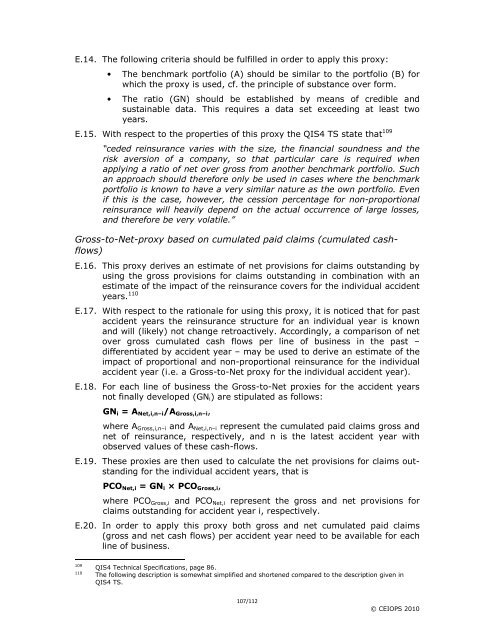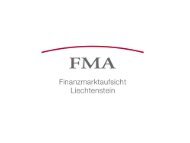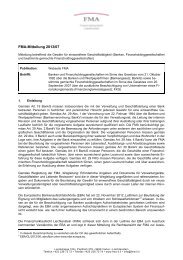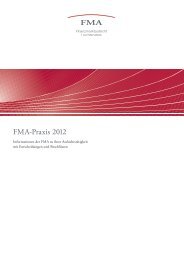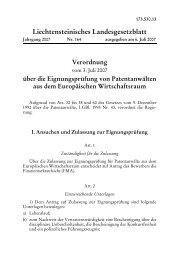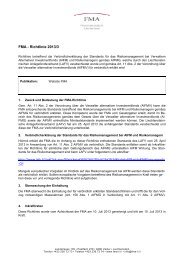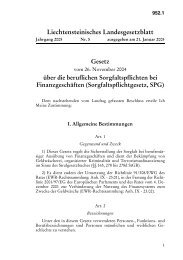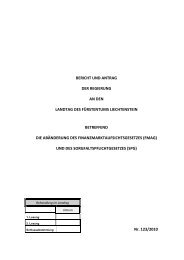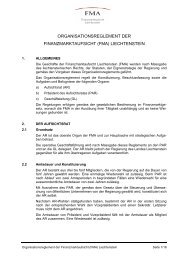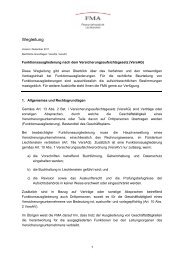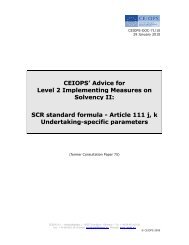CEIOPS' Advice for Level 2 Implementing ... - EIOPA - Europa
CEIOPS' Advice for Level 2 Implementing ... - EIOPA - Europa
CEIOPS' Advice for Level 2 Implementing ... - EIOPA - Europa
Create successful ePaper yourself
Turn your PDF publications into a flip-book with our unique Google optimized e-Paper software.
E.14. The following criteria should be fulfilled in order to apply this proxy:<br />
• The benchmark portfolio (A) should be similar to the portfolio (B) <strong>for</strong><br />
which the proxy is used, cf. the principle of substance over <strong>for</strong>m.<br />
• The ratio (GN) should be established by means of credible and<br />
sustainable data. This requires a data set exceeding at least two<br />
years.<br />
E.15. With respect to the properties of this proxy the QIS4 TS state that 109<br />
“ceded reinsurance varies with the size, the financial soundness and the<br />
risk aversion of a company, so that particular care is required when<br />
applying a ratio of net over gross from another benchmark portfolio. Such<br />
an approach should there<strong>for</strong>e only be used in cases where the benchmark<br />
portfolio is known to have a very similar nature as the own portfolio. Even<br />
if this is the case, however, the cession percentage <strong>for</strong> non-proportional<br />
reinsurance will heavily depend on the actual occurrence of large losses,<br />
and there<strong>for</strong>e be very volatile.”<br />
Gross-to-Net-proxy based on cumulated paid claims (cumulated cashflows)<br />
E.16. This proxy derives an estimate of net provisions <strong>for</strong> claims outstanding by<br />
using the gross provisions <strong>for</strong> claims outstanding in combination with an<br />
estimate of the impact of the reinsurance covers <strong>for</strong> the individual accident<br />
years. 110<br />
E.17. With respect to the rationale <strong>for</strong> using this proxy, it is noticed that <strong>for</strong> past<br />
accident years the reinsurance structure <strong>for</strong> an individual year is known<br />
and will (likely) not change retroactively. Accordingly, a comparison of net<br />
over gross cumulated cash flows per line of business in the past –<br />
differentiated by accident year – may be used to derive an estimate of the<br />
impact of proportional and non-proportional reinsurance <strong>for</strong> the individual<br />
accident year (i.e. a Gross-to-Net proxy <strong>for</strong> the individual accident year).<br />
E.18. For each line of business the Gross-to-Net proxies <strong>for</strong> the accident years<br />
not finally developed (GNi) are stipulated as follows:<br />
GNi = ANet,i,n–i/AGross,i,n–i,<br />
where AGross,i,n–i and ANet,i,n–i represent the cumulated paid claims gross and<br />
net of reinsurance, respectively, and n is the latest accident year with<br />
observed values of these cash-flows.<br />
E.19. These proxies are then used to calculate the net provisions <strong>for</strong> claims outstanding<br />
<strong>for</strong> the individual accident years, that is<br />
PCONet,i = GNi × PCOGross,i,<br />
where PCOGross,i and PCONet,i represent the gross and net provisions <strong>for</strong><br />
claims outstanding <strong>for</strong> accident year i, respectively.<br />
E.20. In order to apply this proxy both gross and net cumulated paid claims<br />
(gross and net cash flows) per accident year need to be available <strong>for</strong> each<br />
line of business.<br />
109 QIS4 Technical Specifications, page 86.<br />
110 The following description is somewhat simplified and shortened compared to the description given in<br />
QIS4 TS.<br />
107/112<br />
© CEIOPS 2010


